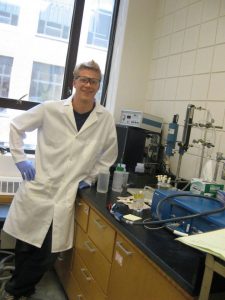Recent mechanical engineering grad is advancing his experience in research at UC Berkeley
 When Payton Goodrich participated in his high school’s robotics program, his passion for mechanical engineering ignited.
When Payton Goodrich participated in his high school’s robotics program, his passion for mechanical engineering ignited.
The Minneapolis native brought that energy to Iowa State and excelled in the classroom and in research projects. Now, he’s starting his Ph.D. at UC Berkeley, something he says has always been his dream.
Goodrich says while he was deciding on a university for his undergraduate degree, he knew he wanted to try living outside a city. The beauty of Iowa State’s campus drew him in, and once he got into the mechanical engineering program, he says it was a warm and welcoming environment.
“I quickly found that making connections and collaborating with classmates was critical to success within the major,” he says. “For example, I am not the best at MatLAB, but I had classmates and friends that helped guide me through the process.”
Goodrich joined Nicole Hashemi, an assistant professor in mechanical engineering, in her research lab to study microbial fuel cells and microfluidics as a sophomore. He threw himself into his research and began revising a draft of a paper about microfluidic fuel cells. Hashemi realized Goodrich’s strong writing skills and encouraged him to become a main contributor to the paper. After three months of digging into dozens of research papers and adding important advancements to the initial draft, Goodrich’s paper was accepted and published in Physical Chemistry Chemical Physics.
Goodrich then began working with Wenyu Huang, an assistant professor in chemistry, in the Science Undergraduate Laboratory Internship (SULI) program. While he only had one chemistry class under his belt, Goodrich quickly learned about synthesizing complex structured platinum nanoparticles. He researched electrochemistry and eventually installed an electrochemical work station, where he conducted experiments to test the catalytic ability of the synthesized nanoparticles. After SULI, Goodrich returned to work with Hashemi.
He picked back up on his research in microfluidics, but at one point broke a silicon wafer worth $5,000. Goodrich says the expensive mishap inspired him to research and create new designs that mimicked the effect of the silicon wafer for considerably less cost.
“I learned that failure is not the only possible outcome from hardship, but the path to grow from my mistakes can be found by approaching the situation with an opportunistic eye,” he adds.
Now Goodrich is settling in at a dream position with UC Berkeley in an industry-focused lab working on The Internet of Things (IoT).
As he continues to expand his research experience, he says one day he hopes to work in research management for a major tech company or create his own startup.